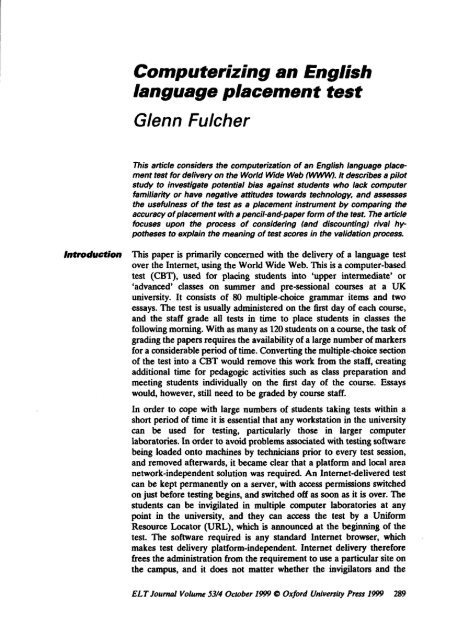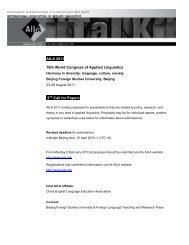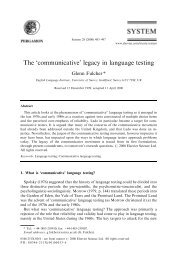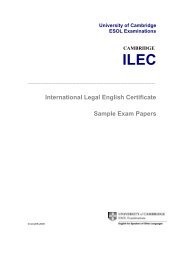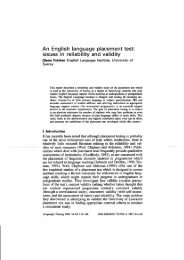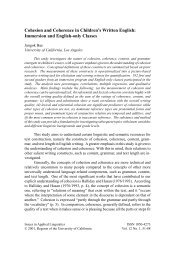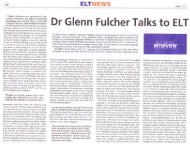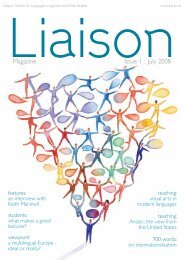Computerizing an English language placement test
Computerizing an English language placement test
Computerizing an English language placement test
Create successful ePaper yourself
Turn your PDF publications into a flip-book with our unique Google optimized e-Paper software.
Introducf;ion<br />
<strong>Computerizing</strong> <strong>an</strong> <strong>English</strong><br />
I<strong>an</strong>guage <strong>placement</strong> <strong>test</strong><br />
Glenn Fulcher<br />
This article considers the computerization of <strong>an</strong> <strong>English</strong> l<strong>an</strong>guage plac*<br />
ment <strong>test</strong> for delivery on the World Wide Web (WWWI. lt describes a pilot<br />
study to investigate potential bias against students who lack computer<br />
familiarity or have negative attitudes towards technology, <strong>an</strong>d assesses<br />
the usefulness of the tesf as a <strong>placement</strong> instrument by comparing the<br />
ac'curacy of <strong>placement</strong> with a pencil-<strong>an</strong>d-papr form of the tesf. The article<br />
focuses upon the process of considering bnd discountind rival hyptheses<br />
to explain the me<strong>an</strong>ing of <strong>test</strong> scores in the validation process.<br />
This paper is primarily concerned with the delivery of. a l<strong>an</strong>guage <strong>test</strong><br />
over the Internet, using the World lVide tffeb. This is a computer-based<br />
<strong>test</strong> (CBT), used for placing students into 'opper intermediate' or<br />
'adv<strong>an</strong>ced' classes on summer <strong>an</strong>d pre-sessional counles at a UK<br />
university. It consists of 80 multiple-choice gr<strong>an</strong>rmar items <strong>an</strong>d two<br />
essays. The <strong>test</strong> is usually administered on the first day of each cours{e,<br />
<strong>an</strong>d the staff grade all <strong>test</strong>s in time to place students in classes the<br />
following morning. With as m<strong>an</strong>y as L20 students on a courre, the task of<br />
grading the papers requires the availability of a large number of markers<br />
for a considerable period of time. Converting the multiple-choice section<br />
of the <strong>test</strong> into a CBT would remove this work from the staff, creating<br />
additional time for pedagogic activities such as class preparation <strong>an</strong>d<br />
meeting students individually on the first day of the course. Essays<br />
would, however, still need to be graded by course staff.<br />
In order to cope with large numbers of students taking <strong>test</strong>s within a<br />
short period of time it is essential that <strong>an</strong>y workstation in the university<br />
c<strong>an</strong> be used for <strong>test</strong>ing, particularly those in larger computer<br />
laboratories. In order to avoid problems associated with <strong>test</strong>ing software<br />
being loaded onto machines by technici<strong>an</strong>s prior to every <strong>test</strong> session,<br />
<strong>an</strong>d removed afterwards, it became clear that a platforrr <strong>an</strong>d local area<br />
network-independent solution was required. An lnternetdelivered <strong>test</strong><br />
c<strong>an</strong> be kept penn<strong>an</strong>ently on a seryer, with acoess permissions switched<br />
on iust before <strong>test</strong>ing begrns, <strong>an</strong>d switched off as soon as it is over. The<br />
students c<strong>an</strong> be invigilated in multiple computer laboratories at <strong>an</strong>y<br />
point in the university, <strong>an</strong>d they c<strong>an</strong> access the <strong>test</strong> by a Uniform<br />
Resource Locator (URL), which is <strong>an</strong>nounced at the beginning of the<br />
<strong>test</strong>. The software required is <strong>an</strong>y st<strong>an</strong>dard Internet browser, which<br />
makes <strong>test</strong> delivery platforrr-independent. Internet delivery therefore<br />
frees the administration from the requirement to use a particular site on<br />
the camps, <strong>an</strong>d it does not matter whether the invigilaton <strong>an</strong>d the<br />
ELT fournal Volune 53/4 October 1999 @ Oxford Univercity Pras 1999 289
course cmrdinators are able to book PC or Macintosh laboratories.<br />
Beoearch The introduction of a new medium for assessment requires considerable<br />
queations thought <strong>an</strong>d research. Although the motivation for a ch<strong>an</strong>ge in the<br />
delivery of the multiple-choice section of the <strong>test</strong> is to cteate time for<br />
pedagogic reasons, it is vital that the information gained from <strong>test</strong> scores<br />
is appropriate for the decisions that will be based on them. This is a<br />
rnatter of equity <strong>an</strong>d fairness in <strong>test</strong>ing practice.<br />
Equity tn<br />
eomputel'62lrld<br />
<strong>test</strong>ing<br />
The illusory<br />
equivalerrce of forrns<br />
2n<br />
The project described in this article, therefore, was motivated by <strong>an</strong><br />
awareness that educators had to ensure the introduction of a CBT<br />
delivered on the Interrtet, using a st<strong>an</strong>dard Internet browser, in such a<br />
way that it would not disadv<strong>an</strong>tage <strong>an</strong>y students. It was also essential for<br />
the CBT to provide accurate infonnation upon which appropriate<br />
<strong>placement</strong> decisions could be made. Specifically, we wished to know:<br />
(a) Is the objective part of the <strong>placement</strong> <strong>test</strong> sufficiently reliable for its<br />
purpose?<br />
(b) How well arc the CBT <strong>an</strong>d pencil-<strong>an</strong>d-paper versions of the <strong>test</strong><br />
correlated?<br />
(c) Is the CBT better or worse at placing students into appropriate<br />
classes?<br />
(d) Are scores signific<strong>an</strong>tly affected by familiarity with computers,<br />
attitudes to computer delivery of <strong>test</strong>s, or <strong>test</strong>-taker background?<br />
The questions were addressed rning a sample of 57 students who took<br />
both the paper-<strong>an</strong>d-pencil <strong>an</strong>d the computer-based forms of the <strong>test</strong> in<br />
1997. Whilst this is not a large sample, it is nevertheless adequate to<br />
investigate the first three questions with confidence, <strong>an</strong>d to <strong>test</strong> for main<br />
effects, if not interactions, on the final question.<br />
Computer-based <strong>test</strong>s are subject to the same st<strong>an</strong>dards of reliability <strong>an</strong>d<br />
validity that would be expected of <strong>an</strong>y other <strong>test</strong>. However, in the case of<br />
computer-based <strong>test</strong>s, certain critical issues of equity have been raised.<br />
The classic statement of these concerns may be summaized from the<br />
GuWelines for Computer Based Tests <strong>an</strong>d Interpretatiorts (APA: 1986):<br />
Test developers should demonstrate that paper-<strong>an</strong>d-pencil <strong>an</strong>d<br />
computer-based versions of a <strong>test</strong> are equivalent forms.<br />
The two forms of the <strong>test</strong> should r<strong>an</strong>k <strong>test</strong>-takers in approximately the<br />
same way.<br />
The me<strong>an</strong>s <strong>an</strong>d st<strong>an</strong>dard deviations of the two forms should be<br />
approximately the same.<br />
These guidelines give <strong>an</strong> indication of what is to be expected of a<br />
computer-based <strong>test</strong> that has been converted from a <strong>test</strong> that already<br />
exists in paper-<strong>an</strong>d-pencil format. The criteria laid dorrm by the APA<br />
relate to the strong posibility that in the tr<strong>an</strong>slation of the <strong>test</strong> from one<br />
medium to <strong>an</strong>other, the new medium may ch<strong>an</strong>ge the nature of the<br />
construct underlying the <strong>test</strong>, or alter the scale. These are serious issues.<br />
However, the requireuient that forms are equivalent is somewhat<br />
Glenn hilcher
estrictive. It is, for example, quite possible to imagine a situation in<br />
which a CBT form provides better <strong>placement</strong> information th<strong>an</strong> its<br />
pencil-<strong>an</strong>d-paper form. If the scale has been altered, the users of <strong>test</strong><br />
scores must be certain that with the introduction of the CBT the new<br />
score me<strong>an</strong>ing is understood <strong>an</strong>d interpreted appropriately.<br />
A great deal of useful work has been conducted into the equivalence of<br />
paper-<strong>an</strong>d-pencil with computer-based forms of <strong>test</strong>s, most of which<br />
provide evidence that achieving equivalence is difficult. Bunderson et al.<br />
(1989) provide <strong>an</strong> overview of studies of <strong>test</strong> equivalence to the end of<br />
the last decade which shows that three studies had recorded a higher<br />
score on computer-based <strong>test</strong>s, 13 had shown higher scores on the paper<strong>an</strong>d-pencil<br />
<strong>test</strong>, <strong>an</strong>d 11 had shown no difference in ssores across forms.<br />
They concluded that lack of familiarity with computers could be<br />
assumed to be a major factor in achieving lower scores on computerbased<br />
<strong>test</strong>s, but that scores on paper-<strong>an</strong>d-pencil <strong>test</strong>s were lower for<br />
younger <strong>test</strong>-takers who had not been familiarized with the method of<br />
completing the <strong>an</strong>swer booklet. The issue of familiarity is not new in<br />
l<strong>an</strong>guage <strong>test</strong>ing. It has always been accepted that <strong>test</strong>-takers should be<br />
familiar with the item types <strong>an</strong>d mode of <strong>test</strong> delivery before taking a<br />
<strong>test</strong> to ensure that these factors would not be confounding variables in<br />
score interpretation. On a similar point, Russell <strong>an</strong>d H<strong>an</strong>ey (1997)<br />
recently suggested that it is becoming increasingly unfair to <strong>test</strong> writing<br />
ability by paper-<strong>an</strong>d-pencil in situations where learners have become<br />
used to composing directly on word processotr. In this case, one would<br />
expect the computer-delivered version of a uniting <strong>test</strong>'to result in<br />
higher scores simply because of familiarity. Yet the higher score would<br />
more accurately reflect the ability to be <strong>test</strong>ed. Familiarity with <strong>test</strong><br />
format <strong>an</strong>d item types is essential for all <strong>test</strong>ing, <strong>an</strong>d however much it<br />
has become associated with it in recent literature it is not specific to<br />
computenzed <strong>test</strong>ing.<br />
The most recent meta-<strong>an</strong>alysis of equivalence of paper-<strong>an</strong>d-pencil with<br />
computer-based forms of <strong>test</strong>s has been conducted by Mead <strong>an</strong>d<br />
Drasgow (1993). This study is concerld, as most other studies have<br />
been, with tbe method of delivery-whether by paper-<strong>an</strong>d-pencil or<br />
computer. It also includes two other variables: conventional vs. adaptive<br />
<strong>test</strong>s <strong>an</strong>d power vs. speeded <strong>test</strong>s. The difference between conventional<br />
<strong>an</strong>d adaptive <strong>test</strong>s is not relev<strong>an</strong>t to the project discussed in this paper,<br />
but speededness should be considered. It seems likely that the<br />
speededness of the <strong>test</strong> may affect scores across forms. On the computer<br />
screen, the fact that scrolling has to be operated by the <strong>test</strong>-taker could<br />
result in a score reduction on the computer-based form. Mead <strong>an</strong>d<br />
Drasgow (1993) report that in the meta-<strong>an</strong>alysis of. 28 studies, the<br />
computer <strong>test</strong>s were slightly harder th<strong>an</strong> their paper-<strong>an</strong>d-pencil counterparts,<br />
but that the only variable to signific<strong>an</strong>tly affect scores was<br />
speededness. Whilst the correlation between <strong>test</strong>s was on average 0.91<br />
for different administration modes, the average cross-mode correlation<br />
for speeded <strong>test</strong>s was 0.72. One pocsible expl<strong>an</strong>ation for this finding is<br />
the differences in motor skills required of paper-<strong>an</strong>d-pencil compared to<br />
<strong>Computerizing</strong> a plaement lest
292<br />
Further equQ<br />
issues<br />
computer-based respolrse techniques, when working under severe time<br />
limits. However, timed-power <strong>test</strong>s show no signific<strong>an</strong>t influence of<br />
medium on <strong>test</strong> scores. Mead <strong>an</strong>d Drasgow (1993: 456) conservatively<br />
state that although 'a computerized version of a timed power <strong>test</strong> c<strong>an</strong> be<br />
constructed to measure the same trait as a coresponding paper-<strong>an</strong>dpencil<br />
form' it should not be taken for gr<strong>an</strong>ted for <strong>an</strong>y computerized<br />
<strong>test</strong>. This should be a warning that future computer-based <strong>test</strong>s should<br />
be submitted to the same rigorous scrutiny as previous computerized<br />
<strong>test</strong>s, especially if they are speeded.<br />
This review indicates that <strong>an</strong>y attempt to achieve equivalence of forms is<br />
likely to fail. Scores will vary between the pencil-<strong>an</strong>d-paper <strong>an</strong>d CBT<br />
forms of a <strong>test</strong>. However, it is still incurnbent upon <strong>an</strong> institution to<br />
ensure that signific<strong>an</strong>t score variations associated with a CBT do not<br />
introduce a bias into the results. As we have seen, this is as relev<strong>an</strong>t to<br />
the investigation of pencil-<strong>an</strong>d-paper fgrms as it is to the CBT.<br />
Although the issue of equivalence of forms has dominated the discussion<br />
of computer-based <strong>test</strong>ing, this is not the only equity consern. Other<br />
equity issues relate directly to:<br />
Previous experience of using computers. Factors in this mtegory<br />
inctude the familiarity of <strong>test</strong>-takers with the cornputer itself, the<br />
frequency with which a computer is used (if at all), <strong>an</strong>d familiarity<br />
with the .m<strong>an</strong>ipulation of a mouse s'ith two buttons. If the <strong>test</strong> is<br />
delivered over the Internet using a st<strong>an</strong>dard browser such as Netscape<br />
or Internet Explorer, familiarity with the WWW (perhapa also<br />
including frequency of e-mail use) should be taken into ac@unt.<br />
Attitudes of <strong>test</strong>-takers to computers, the software being used (the<br />
degree of user-friendliness, for example), <strong>an</strong>d the WWW in general,<br />
also need to be investigated. It is at least feasible to suggest that<br />
negative attitudes to the medium of delivery could have <strong>an</strong> impact<br />
upon <strong>test</strong> scores, <strong>an</strong>d this may be more likely among those with little<br />
or no experience of using computers or the Internet.<br />
Finally, the background of the <strong>test</strong>-taker may be relev<strong>an</strong>t to the<br />
validity of the <strong>test</strong> s@re. Background factors worthy of investigation<br />
would seem to be og€, gender, primary l<strong>an</strong>guage background (L1),<br />
<strong>an</strong>d level of education or subject specialism in the case of applic<strong>an</strong>ts<br />
for university places.<br />
The largest move to cornputer-based <strong>test</strong>ing was the introduction of the<br />
computer-based TOEFL in 1998. Educational Testing Service (ETS) has<br />
conducted a signific<strong>an</strong>t amount of research on the TOEFL takers' access<br />
to <strong>an</strong>d experience with computers, in their attempt to design a<br />
computer-based TOEFL that is minimally dependent upon previous<br />
experience. In the case of ETS, this has involved the development of a<br />
tutorial package that <strong>test</strong>-takers do prior to taking the TOEFL.<br />
Taylor, Jamieson, Eigpor, <strong>an</strong>d Kirsch (1997; 1998) investigated<br />
computer familiarity in the TOEFL <strong>test</strong>-taking population <strong>an</strong>d its effect<br />
Glenn Fulclur
on <strong>test</strong> soores, including gender <strong>an</strong>d Ll as variables. Using <strong>an</strong>alysis of<br />
covari<strong>an</strong>ce (ANCOVA), Taylor et al. argue that signific<strong>an</strong>t statistical<br />
relationships between some of the sub-<strong>test</strong>s of the TOEFL <strong>an</strong>d<br />
computer farniliarity were so small as to be of no practical import<strong>an</strong>ce,<br />
<strong>an</strong>d that the same picture emerged for gender <strong>an</strong>d geographical location.<br />
In total, the scores of around20olo of TOEFL <strong>test</strong>-takers may be affected<br />
by the computer-based form, although it is assumed that the tutorial<br />
package will further minimize this. Despite the claims of Taylor et al.,<br />
introducing the computer$ased <strong>test</strong> will have a signific<strong>an</strong>t impact on at<br />
least one fifth of <strong>test</strong>-takers. This is not <strong>an</strong> insignific<strong>an</strong>t numbern <strong>an</strong>d so<br />
further research is needed. It is also interesting to note that Educational<br />
Testing Services decided riot to introduce the computer-based TOEFL<br />
into East Asia as pl<strong>an</strong>ned (Educational Testing Services 1998).<br />
Method The reliability of the 80-item objective component of the pre-sessional<br />
<strong>placement</strong> <strong>test</strong> was investigated using a sample of 57 students enrolled<br />
on pre-sessional courses during l9F,7.The <strong>test</strong> is entirely multiple+hoice,<br />
<strong>an</strong>d has been used in the pre-sessional programme at the university for<br />
five years in its current format. Although the <strong>test</strong> has been little studied,<br />
the teachers who mark it <strong>an</strong>d use it to place students in class have<br />
consistently reported that they are happy with the <strong>placement</strong> decisions<br />
taken on the basis of the scores, in conjunction with the essay results.<br />
The <strong>test</strong> was computewpd, using QU Web (Roberts 1995; see also<br />
Fulcher 1997), <strong>an</strong>d loaded onto a web server. Authorizing access to the<br />
<strong>test</strong>, downloading <strong>test</strong> scores on the server, <strong>an</strong>d compiling the <strong>test</strong><br />
results, was undertaken remotely from a personal computer.<br />
Fifty-seven students enrolling for courses in J<strong>an</strong>uary Dn took the <strong>test</strong><br />
in a st<strong>an</strong>dard university computing laboratory using the Netscape 3.0<br />
Internet browser, <strong>an</strong>d its paper-<strong>an</strong>d-pencil form. The <strong>test</strong> is a timedpower<br />
<strong>test</strong>, <strong>an</strong>d was designed to take 45 minutes in total. The computing<br />
laboratory was invigilated by two course tutors, who helped students log<br />
on to the <strong>test</strong>, <strong>an</strong>d ensured that each <strong>test</strong>-taker submitted the <strong>an</strong>swers for<br />
scoring on completion of the <strong>test</strong>. The computer-based <strong>test</strong> was taken<br />
within two weeks of the paper-<strong>an</strong>d-pencil <strong>test</strong>. It is acknowledged that<br />
some order effect is inevitable. Nevertheless, this pragmatic decision not<br />
to r<strong>an</strong>domize the order of <strong>test</strong>-taking was taken because students must<br />
be placed into classes on arrival, <strong>an</strong>d it would be unfair to use the CBT<br />
to do this iself before its properties could be established. However, this<br />
is not a confounding factor in the design of the study, since the matter of<br />
strict equivalence is not <strong>an</strong> issue only of the relationship of the two <strong>test</strong>s<br />
<strong>an</strong>d the power of student <strong>placement</strong>, or classification. The only impact of<br />
the ordered adrninistration is on the increase in me<strong>an</strong> scores on the<br />
CBT.<br />
After taking the CBT, data was collected from each student on<br />
computer familiarity. This recorded frequency of computer use,<br />
familiarity with the mouse, farniliarity with the WWW, <strong>an</strong>d frequency<br />
of e-mail use. Attitudes towards taking <strong>test</strong>s on the Internet included a<br />
Compwerizing a <strong>placement</strong> <strong>test</strong>
Beguttr <strong>an</strong>d<br />
digcurcion<br />
Reliability<br />
Relationship of the<br />
paper-<strong>an</strong>d-pencil<br />
form to the WWW<br />
form<br />
preference for paper-<strong>an</strong>d-pencil format, a preference for Internet<br />
format, <strong>an</strong>d a student-estimated likelihood of getting a higher grade<br />
on one <strong>test</strong> or the other. Background information on the <strong>test</strong>-taker<br />
included d1e, gender, Primary l"<strong>an</strong>guage Background, <strong>an</strong>d subject area<br />
specialism (the subject students intend to study at univenity).<br />
The data were <strong>an</strong>alysed to compare the <strong>test</strong> scores for the sample of<br />
students across the tryo <strong>test</strong> fornrats. Scores on the computer-based <strong>test</strong><br />
were investigated using ANCOVA for the effect of computerfamiliarity,<br />
attitudes, <strong>an</strong>d the <strong>test</strong>-taker's background. In this pr@ess<br />
the paper-<strong>an</strong>d-pencil based <strong>test</strong> was used as a covariate to take ability<br />
into account. .<br />
Test reliability was estimated using Cronbach's alpha. Reliability for the<br />
paper-<strong>an</strong>d-pencil <strong>test</strong> was estirnated at 0.90, while the reliability of the<br />
cornputer-based <strong>test</strong> was 0.95. This indicates that further investigation<br />
into variation in <strong>test</strong> scores should not be confounded by r<strong>an</strong>dom error.<br />
First, descriptive statistics were calculated for the two io* of the <strong>test</strong><br />
(see Table 1). The difference between the me<strong>an</strong> of the WWW form<br />
(CBT) <strong>an</strong>d the paper-<strong>an</strong>d-pencil form (TEST) is signific<strong>an</strong>t, as shown in<br />
Table 2, the paired samples t-<strong>test</strong>. Table 3 presents the correlation<br />
between the two forrrs, which is respectably high for this type of study.<br />
It is accepted that the increase in me<strong>an</strong> score on the CBT is due in large<br />
part to <strong>an</strong> order effect, but this in itself is not enough to account for the<br />
possible variation in scores as indicated by the st<strong>an</strong>dard deviation of the<br />
difference of me<strong>an</strong>s.<br />
Tabla l. De*riptive<br />
xatislics N Minimum Maxirnum Me<strong>an</strong> St<strong>an</strong>dard Deviation<br />
Ecores as<br />
Wrcentagasl Paper-<strong>an</strong>d-pencil 57 2s 78 56.58<br />
13.7e<br />
CBT<br />
57 19 80 62.23<br />
14.18<br />
Tabte 2. Paired samples<br />
t-<strong>test</strong> for the two forms<br />
Table 3. Correlation<br />
beUren the tvw forms<br />
294<br />
't<br />
St<strong>an</strong>dard 95% Confidence<br />
Enor of lnterual of the<br />
Me<strong>an</strong>s Difference<br />
.. i..:.".,. .., ., ,- . i Me<strong>an</strong> S.D. Lower Upper t df Sig. {2-tailed}<br />
Pair CBT-Test 5.65 S.29 1.10 3.45 7.85 5.14 56<br />
,-J cBT<br />
Pearson Correlation TEST<br />
*Signific<strong>an</strong>t at the 0.01 level E tailed <strong>test</strong>l<br />
The st<strong>an</strong>dard deviation of the difference of me<strong>an</strong>s (see Table 2) is 8.29.<br />
This me<strong>an</strong>s that tor 95Yo of the sample, the score on the CBT could be<br />
<strong>an</strong>lmhere from 10.6 lower to 219 higher th<strong>an</strong> their score on the paper<br />
<strong>an</strong>d-pencil forrr of the <strong>test</strong>. This is <strong>an</strong> indication that a correlation of 0.82<br />
is not high enough to ensure that the CBT is <strong>an</strong> adeguate re<strong>placement</strong><br />
for the paper-<strong>an</strong>d-pencil version of the <strong>test</strong>. However, as we have argued<br />
above, this does not me<strong>an</strong> to say that the CBT is not a better <strong>placement</strong><br />
Glenn Fule.lwr
Bias<br />
Table 4. Cbmputer<br />
familiarity<br />
Table 5. Attitudes<br />
towards taking <strong>test</strong>s on<br />
the lnternet<br />
instrument th<strong>an</strong> the pencil-<strong>an</strong>d-paper form of the <strong>test</strong>. We return to this<br />
issue below.<br />
In Tables 4 to 6, the areas of computer familiarity, attitudes towards<br />
taking <strong>test</strong>s on the Internet, <strong>an</strong>d towards the <strong>test</strong>-taker's background<br />
were investigated. The CBT was the dependent variable in each cas€,<br />
<strong>an</strong>d the paper-<strong>an</strong>d-pencit <strong>test</strong> (labelled 'TEST') was used as a covariate<br />
to take ability into account. In each sase Analysis of Covari<strong>an</strong>ce<br />
(ANCOVA) is used. It should be stressed that with 57 cases these results<br />
should be treated with some caution; whilst it is possible to <strong>test</strong> for main<br />
effects, interaction effects (if present) could not be detected without a<br />
much larger dataset.<br />
The independent variables of frequency of computer use, familiarity<br />
with the mouse, <strong>an</strong>d frequency of use for the WWW <strong>an</strong>d e-mail (listed in<br />
the left h<strong>an</strong>d column) were measured on a five-point Likert scale. Table<br />
4 shows that there are no signific<strong>an</strong>t main effects on the CBT scores.<br />
TEST<br />
FREOUENCY<br />
MOUSE<br />
www<br />
EMAIL<br />
df<br />
1<br />
4<br />
4<br />
4<br />
4<br />
40.00<br />
1.46<br />
1.42<br />
.17<br />
.86<br />
sig.<br />
.00<br />
.26<br />
.28<br />
.95<br />
.51<br />
In measuring attitudes towards <strong>test</strong>ing format, <strong>test</strong>-takers were asked to<br />
respond to two five-point Likert items, one of which asked if they liked<br />
taking paper-<strong>an</strong>d-pencil <strong>test</strong>s (LIKETEST) <strong>an</strong>d one which asked if they<br />
liked taking the Internet-based <strong>test</strong> (LIKECBT). Next, they were asked<br />
to say, with only two options, on which <strong>test</strong> they thought they would get<br />
the highest score (CBTBETTER), <strong>an</strong>d finally, if they were given a<br />
choice of paper-<strong>an</strong>d-pencil or a somputer-based <strong>test</strong>, which one would<br />
they choose. Again, there was no signific<strong>an</strong>t impact of attitudes on the<br />
computer-based <strong>test</strong> scores, as demonstrated in Table 5.<br />
Soutro sig-<br />
TEST<br />
LIKE CBT<br />
LIKETEST<br />
CETBETTER<br />
cHotcE<br />
1<br />
3<br />
4<br />
3<br />
2<br />
19.25<br />
0.37<br />
1.19<br />
2.00<br />
0.25<br />
.00<br />
,78<br />
.35<br />
.15<br />
.78<br />
Finally, the background of the <strong>test</strong>-taker was investigated. The himary<br />
l<strong>an</strong>guage Background (L1) was classified only as lndo-Europe<strong>an</strong> or<br />
non-Indo€urope<strong>an</strong>. As all the <strong>test</strong>-taken were applying to attend<br />
@urses at UK universities, their subject areas were classified into one of<br />
three categories: science, engineering, or hum<strong>an</strong>ities <strong>an</strong>d social sciences'<br />
The results are presented in Table 6.<br />
<strong>Computerizing</strong> a <strong>placement</strong> trsit<br />
295
Table 6. Background of<br />
the <strong>test</strong>-taker<br />
296<br />
Bias or better<br />
<strong>placement</strong>?<br />
Examining<br />
competing<br />
hypotheses in<br />
validitv studies<br />
TEST<br />
AGE<br />
GENDER<br />
LT<br />
SUgJECT<br />
1<br />
16<br />
1<br />
1<br />
2<br />
sig.<br />
76.63 .00<br />
1.82 .126<br />
0.00 .98<br />
6.56 .O2<br />
1.12 .35<br />
The only signific<strong>an</strong>t effect discovered was that of Primary L<strong>an</strong>guage<br />
Background (L1). The me<strong>an</strong> score of students speaking Indo-Europe<strong>an</strong><br />
l<strong>an</strong>guages on the computer-based <strong>test</strong> was 64.18, with a st<strong>an</strong>dard<br />
deviation of 14.L3. Speakers of non-lndo-Europe<strong>an</strong> l<strong>an</strong>guages, on the<br />
other h<strong>an</strong>d, had a me<strong>an</strong> of 61.40, <strong>an</strong>d a st<strong>an</strong>dard deviation of. 14.31.<br />
However, on the paper-<strong>an</strong>d-pencil <strong>test</strong>, there was no signific<strong>an</strong>t<br />
difference between these two gfoup. There does, therefore, appear to<br />
be a possibility that some learners (mostly from Jap<strong>an</strong> <strong>an</strong>d Korea, in this<br />
sample) may be placed into a lower grouP on the CBT.<br />
One possible expl<strong>an</strong>ation for this result may lie in the principle of<br />
'uncertainty avoid<strong>an</strong>ce'. In cross-cultural studies conducted by Hofstede<br />
(19E3, t9&4; see also discussion in Riley 19SS) it has been demonstrated<br />
that Jap<strong>an</strong>ese subjects suffer a greater degree of stress th<strong>an</strong> other<br />
nationalities when asked to do unfamiliar tasks. Hofstede was<br />
conducting research for IBM into the computerization of business<br />
tasks in industry. It was discovered that workers who were familiar with<br />
using computers in the workplace, <strong>an</strong>d familiar with carrying out certain<br />
tasks, suffered from signific<strong>an</strong>tly increased stress levels when asked to do<br />
the task on the computer. The combination produced <strong>an</strong> unoertainty<br />
that in turn created more stress, <strong>an</strong>d <strong>an</strong> increase in the likelihood of<br />
making mistakes. In the case of computerized <strong>test</strong>s, a <strong>test</strong>-taker may be<br />
familiar with taking <strong>test</strong>s of various types, <strong>an</strong>d may be familiar with<br />
computers. But if they have never taken a <strong>test</strong> on a computer, the fear of<br />
'doing old things in new ways' becomes <strong>an</strong> import<strong>an</strong>t factor that c<strong>an</strong><br />
affect <strong>test</strong> scores. This particular expl<strong>an</strong>ation would go a long way to<br />
accounting for the signific<strong>an</strong>t findings presented in Table 6, whilst<br />
accounting for non*ignific<strong>an</strong>t results for all other factors that could<br />
account for variability in <strong>test</strong> scores.<br />
One key elernent in <strong>test</strong> validation is the provision of theories that best<br />
account for the empirical data (Messick 1989). Although variability in<br />
scores across <strong>test</strong> formats are normally accounted for by theories like the<br />
one presented above, it should not be forgotten that differences between<br />
groups of students on <strong>test</strong> scores may rePresent differences in ability'<br />
rather th<strong>an</strong> bias. This could come about because of the shared learning<br />
experiences of certain groups of students, or the dist<strong>an</strong>ce between their<br />
Ll <strong>an</strong>d the target l<strong>an</strong>guage. It is therefore import<strong>an</strong>t to investigate the<br />
extent to which the CBT is bener at placing students into coherent<br />
teaching groups-arguably the most import<strong>an</strong>t validity criterion for the<br />
evaluation of a <strong>placement</strong> <strong>test</strong>'<br />
Glcnn Fulcher
Table 7. Dixrimination<br />
betvveen fiw groups on<br />
the CBT <strong>an</strong>d Wncil<strong>an</strong>dparyr<br />
forms<br />
Table 8. Me<strong>an</strong>s of groups<br />
bY <strong>test</strong> form<br />
Std. error<br />
It s'ill be recalled that when the pencil-<strong>an</strong>d-paper <strong>test</strong> is used, <strong>placement</strong><br />
decisions are only made after two pieces of written work have been<br />
graded. Teachers then meet to consider all grades <strong>an</strong>d assign students to<br />
one of two initial <strong>placement</strong> levels. It is assurned that this longer process,<br />
including evidence from the writing tasks, is more accurate th<strong>an</strong> relying<br />
on the results of the objective <strong>test</strong> alone. Inter-rater reliability for<br />
assessment of the writing is calculated at 0.87. The question that needs to<br />
be asked is whether the CBT is better th<strong>an</strong> the pencil-<strong>an</strong>d-paper forrn of<br />
the <strong>test</strong> on its own at predicting the final <strong>placement</strong> decision. If it is, the<br />
CBT would provide better quality information to teachers making<br />
<strong>placement</strong> decisions th<strong>an</strong> the pencil-<strong>an</strong>d-paper form of the <strong>test</strong>. (Note<br />
that the nniting <strong>test</strong> would still be used: the question posed here is<br />
related to the quality of information provided by one part of the <strong>test</strong>.<br />
Improving this increases the utility of the <strong>test</strong> score as a whole.) In Table<br />
7, we c<strong>an</strong> see the results of a one-way ANOVA study to investigate this<br />
question. It c<strong>an</strong> be seen that the me<strong>an</strong> scores of the final <strong>placement</strong><br />
groups are signific<strong>an</strong>tly different on the CBT, but not signific<strong>an</strong>tly<br />
different on the pencil-<strong>an</strong>d-paper <strong>test</strong>. In other words, the CBT predicts<br />
final decisions more accurately th<strong>an</strong> the pencil-<strong>an</strong>d-paper <strong>test</strong>.<br />
CBT Between groups<br />
TEST<br />
Within groups<br />
Total<br />
Between groupg<br />
Within groups<br />
Total<br />
Sum of cqueree df Mc<strong>an</strong> lquffs<br />
1,w2,747<br />
10,137,2&l<br />
11,230,035<br />
176,932<br />
10,460862<br />
10,6it7,895<br />
1<br />
55<br />
56<br />
1<br />
55<br />
5bi;'<br />
1,092,747<br />
1f,p,,314<br />
176,932<br />
190,199<br />
5,929 .018<br />
930 .f,tg<br />
Comparing the (ne<strong>an</strong>s of Group 1 (adv<strong>an</strong>ced) with Group 2 (upperintermediate),<br />
we c<strong>an</strong> see the greater discriminatory power of the CBT<br />
in Table 8.<br />
Grcup Advrnced Upper-intcrmediate<br />
CBT<br />
TEST<br />
71.18<br />
60.18<br />
Me<strong>an</strong><br />
8.89<br />
7.45<br />
sd.<br />
2.8<br />
2.25<br />
Std. error Me<strong>an</strong><br />
60.09 14.41<br />
55.72 14.U<br />
We have presented two cases. The first suggests that the CBT score$ are<br />
contaminated by <strong>an</strong> Ll. background factor, making <strong>placement</strong> decisions<br />
suspect <strong>an</strong>d unfair to students from East Asia. The second case suggests<br />
that the CBT is more sensitive to variation in l<strong>an</strong>guage ability (likely to<br />
be retated to LL background) <strong>an</strong>d contributes more information th<strong>an</strong> the<br />
pencil-<strong>an</strong>d-paper <strong>test</strong> to a fair <strong>an</strong>d valid <strong>placement</strong> decision. In this<br />
iecond case, there is <strong>an</strong> implication that it is the mode of delivery of the<br />
pencil-<strong>an</strong>d-paper form that interferes with the discriminatory power of<br />
the <strong>test</strong> items.<br />
Compuwizing a phcenent <strong>test</strong><br />
sd.<br />
2.13<br />
2.19<br />
2n
The interpretation of the data that is preferred by the institution will<br />
have <strong>an</strong> impact upon the irnmediate future learning environment of-the<br />
student. It is incumbent upon <strong>test</strong> developers <strong>an</strong>d userc within<br />
institutions to be aware of the rival interpretation of <strong>test</strong> scores, <strong>an</strong>d<br />
to be aware of the impact of accepting one hypothesis over <strong>an</strong>other too<br />
readily or, worse, without considering possible rival hypotheses at all.<br />
Conclugions In <strong>an</strong>swer to the research questions posed, it has been discovered that<br />
the CBT is sufficiently reliable for its purpose, <strong>an</strong>d that the two forms<br />
are correlated-but not higtrly enough for accurate prediction of a score<br />
on one form of the <strong>test</strong> from a score on the other form. It has been<br />
discovered that the CBT provides better information th<strong>an</strong> the pencil<strong>an</strong>d-paper<br />
<strong>test</strong> in ptacing students into onc of two grouP6, but that there<br />
may be some bias against students with certain LL backgrounds.<br />
The question that remains for this institution is whether to implement<br />
the CBT (alongside the existing writing <strong>test</strong>s) on the basis of this<br />
evidence, or to conduct further research that woutd provide further<br />
evidence in support of one of the two hypotheses regarding score<br />
me<strong>an</strong>ing outlined above. In practice, the pedagogic <strong>an</strong>d practical<br />
adv<strong>an</strong>tages to be gained from the CBT are too valuable to waste. As<br />
the CBT appears to contribute more to the decision-making process<br />
th<strong>an</strong> the pencil-<strong>an</strong>d-paper <strong>test</strong>, it is therefore likely that the <strong>test</strong> will be<br />
put into operational use. Any bias present in the <strong>test</strong> would me<strong>an</strong> that<br />
the ihstitution would have a small number of falbe negatives (students<br />
placed into a lower group who should be placed in a higher group), but<br />
ihese individuals are usually identified within a short period of time, <strong>an</strong>d<br />
moved accordingly by the teachers. These <strong>placement</strong> <strong>test</strong>s are not<br />
sufficiently 'high stakes' to cause undue worry.<br />
The gains therefore outnreigh the seriousness of the possible presence of<br />
bias in the CBT. Teachers will be made aware of this possibility, <strong>an</strong>d<br />
additional attention will be paid to students from these L1 backgrounds<br />
in the grading of the essay component of the <strong>test</strong>, <strong>an</strong>d during the<br />
introductory classes.<br />
This article has looked at the issues facing a particular institution over<br />
the introduction of a computer-based <strong>placement</strong> <strong>test</strong> as a re<strong>placement</strong><br />
for its pencil-<strong>an</strong>d-paper multiple-choice <strong>test</strong>. In the process, it has<br />
highlighted the import<strong>an</strong>ce for <strong>an</strong>y institution of considering rival<br />
hypotheses of score me<strong>an</strong>ing when ch<strong>an</strong>ges in assessment practice are<br />
being reviewed.<br />
Received November 199,8<br />
29E Glern Fulcher
Eclercncgls<br />
APA. 1986. Guidelines for Computer Based Tesa<br />
<strong>an</strong>d Interpretations. Washington DC: Americ<strong>an</strong><br />
Psychological Association.<br />
Bunderson, C. V., D. L Inouye, <strong>an</strong>d J. B. Olsen<br />
1989. 'The four generations of computefizd<br />
educational measurement' in R. L. Linn (ed.).<br />
Eduutional Measurement (3rd edn.). Washington,<br />
D.C.: Americ<strong>an</strong> Council on Education.<br />
36747.<br />
Educadonal Te$ing Servicer 1998. TOEFL 1998<br />
Products <strong>an</strong>d Services Catalogue, New Jersey:<br />
ETS.<br />
trblcher, G.1997. 'QM Web: A World Wide Web<br />
<strong>test</strong> delivery program'. L<strong>an</strong>gwge Testing<br />
Update 21: 45-50.<br />
Hofiilede, G. 1983. 'The Cultural Relativity of<br />
Org<strong>an</strong>izational Practices <strong>an</strong>d Theories'. Ioimat<br />
of International Bwiruss Sudies 83: 75-89.<br />
Hofttcde' G. 1984. Culture's Consequenw: Imen<br />
national Dffirences in Work Related Values.<br />
Vol. 5: Croas-Cultural Research <strong>an</strong>d Methodology<br />
Series. Beverly Hills: Sage.<br />
Mced, A. D. <strong>an</strong>d F. Drrsgow. f993. 'Equivalenoe<br />
of computerized <strong>an</strong>d paper-<strong>an</strong>d-pencil cognitive<br />
ability <strong>test</strong>s: A meta-<strong>an</strong>alysis'. Psychological<br />
Bulletin, tl4&: 449-58.<br />
Messick, S. 1.989. 'Validity' in R. L. Linn (ed.).<br />
Educational Measuremqtr. New York Macrnill<strong>an</strong>:<br />
13-1(X.<br />
Riley, P. 1988. 'The Ethnography of Autonorny'<br />
in A. Brooks <strong>an</strong>d P. Grundy (eds.). Individua-<br />
Iization <strong>an</strong>d Autonomy k l^aigrng, Leorning.<br />
ELT Documents 131: lz-Y. London: Modern<br />
<strong>English</strong> Publications in Association with the<br />
British Council.<br />
Robertq, P. 1995. QM Web: Tests <strong>an</strong>d Sumeys on<br />
the Web. [.ondon: Questionmark Computing.<br />
Russell, M. <strong>an</strong>d W. Hrney. t997.'Testing Writing<br />
on Computers: An experirnent comparing student<br />
perform<strong>an</strong>ce on <strong>test</strong>s conducted via computer<br />
<strong>an</strong>d via paper-<strong>an</strong>d-pencil'. Edacation<br />
Polrcy Arwlysis Ardives 5R.<br />
hnp//olam.ed.asu.edu/epaa/v5 rB. htrnl<br />
Teylor, C, J. J. Jrmieson, I). Eignor, <strong>an</strong>d I.<br />
Ifinch. tW7.'Measuring the Effects of Computer<br />
Familiarity on Computer-based l<strong>an</strong>gnge<br />
Tasks'. Paper presented at the L<strong>an</strong>guage Testing<br />
Research ftlloquium, Orl<strong>an</strong>do, Florida.<br />
Ta5ilor, C., J. J. Jamieson, D. Eignor, <strong>an</strong>d<br />
t lfirsch. 1998. Tlw Relationship Between Computer<br />
Familiarity ard Perfonrutnce on Computer-based<br />
TOEFL Test Tasks. New Jensey,<br />
Educational Testing Service: TOEFL Research<br />
Report 61.<br />
Trtc autthor<br />
Glenn Flrlcher is currently Director of the <strong>English</strong><br />
L<strong>an</strong>gnge Institute at the Universiry of Surrey. He<br />
has worked in EFL abroad <strong>an</strong>d in the United<br />
Kingdom since Lgg2, gaining his lvlA in 1985 <strong>an</strong>d<br />
his PhD in l<strong>an</strong>guage <strong>test</strong>ing from the Univenity of<br />
L<strong>an</strong>caster in 1993<br />
E-mail g.fulcherGurrey.ac.uk<br />
Resources in L<strong>an</strong>guage Testing WWW page:<br />
http//wurw.su rrey. ac. ula/ELI/t tr. html<br />
Computerizint a phement <strong>test</strong> 29


